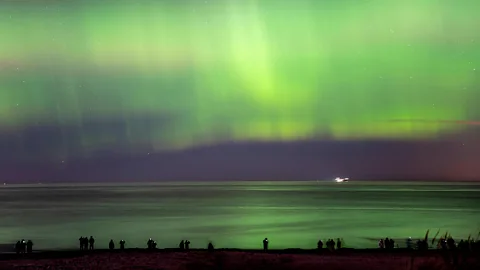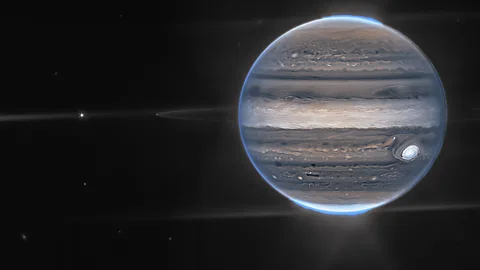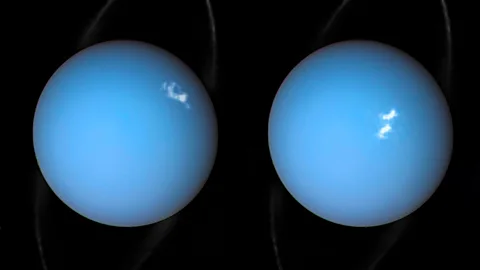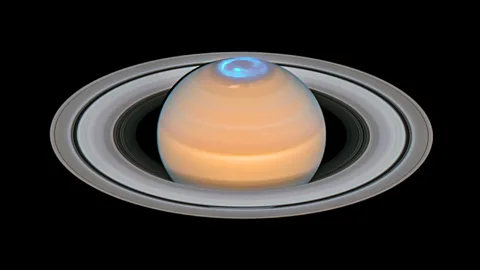By Jonathan O'CallaghanFeatures correspondent

 Getty Images
Getty ImagesThe magical light displays that appear in the skies above the Arctic and Antarctic are being discovered on other planets in our own Solar System and beyond, giving astronomers valuable insights into these alien worlds.
The atmosphere is dancing with light, shifting from one shade to the next. It is a display worthy of the Northern Lights on their most active nights in the snowy reaches of the Arctic Circle. But this light show isn't found here on Earth – it's happening on the planet Uranus.
It is the latest planet of our solar system to have its aurora studied in detail. Researchers at the University of Leicester in the UK recently detected an infrared aurora on the ice giant for the first time, using the Keck Observatory in Hawaii.
"We analysed the planet for six hours to see if there was any variation in infrared brightness," says Emma Thomas, a PhD student studying planetary aurorae at the University of Leicester and the study's lead author. "We saw peaks of intense brightness, which highly suggested auroral emissions."
Although it would be invisible to human eyes, passing spacecraft have picked up other aspects of the aurora that glow around the poles of our Sun's second most distant planet that suggest the light produced flits from ultraviolet to infrared with some radio waves thrown in for good measure.
But it is also far from the only other planet to be found to have an aurora. If our solar system is any indicator, aurorae on planets appear to be pretty common. All eight of the major worlds orbiting our star exhibit some sort of aurora, whether that's caused by magnetic fields or surface activity. Tentative observations in other solar systems also suggest we may find the same is true elsewhere in the Universe.
And for the astronomers detecting these strange, alien light shows, they are providing valuable insights about the worlds that host them, as well as our own planet's aurora borealis and aurora australis.

 Nasa/Esa
Nasa/EsaOn Earth, the aurora is caused by the interaction of our planet's magnetic field with incoming electrically-charged particles from the Sun. As these particles make the 93-million-mile (149 million km) journey to our planet, they can become trapped by our planet's magnetic field, which funnels them to the poles. They then start to collide with atoms and molecules in our atmosphere, producing dramatic curtains of light in the sky that we call the northern or southern lights.
The dramatic variations in colour – or wavelength – that we can see depends on the atoms this barrage of solar particles interacts with. The atoms absorb energy from these collisions and then release it at specific wavelengths of light. Nitrogen, the most common gas in our atmosphere, produces a mostly blue glow. Oxygen, the next most abundant gas, releases green light. The altitude the collisions occur at can also make a difference – red light is released when high-energy particles collide with oxygen atoms at between 125-310 miles (200-500km) above the Earth's surface while it releases green at between 60-155 miles (100km-250km). Similarly, the pinks and purples that are sometimes seen come from collisions with nitrogen atoms at lower altitudes.
On Uranus, the most common gases in its atmosphere are hydrogen and helium, so its aurora is a bit different. Instead of glowing in visible light, it shines at a range of the electromagnetic spectrum invisible to the human eye. The ultraviolet and radio aurora on the planet were first spotted by Nasa's Voyager 2 spacecraft in 1986 as it flew past, but the infrared aurora had gone undetected.
The new finding could prove scientifically valuable. Uranus's upper atmosphere is much hotter than scientists expected for such a distant, icy world. Passing spacecraft have revealed it to be in the region of 220-420C (440-800F) – far hotter than if it had been warmed by the Sun alone and compared to its much larger neighbour Saturn. The latest findings suggest that this effect might be a consequence of heat being injected into the planet by the aurora. "Now that we've been able to see the infrared aurora we can start looking for that being a process," says Thomas.
Uranus' aurora could also give us a key insight into a feature of Earth's magnetic field, namely that it appears to reverse in polarity every so often. In the past 20 million years, the magnetic field has flipped around 3-5 times every million years, switching its north magnetic pole to the south and vice versa (it isn't a cyclical occurrence, however, and has been more than 780,000 years since the last reversal while during the Cretaceous period our planet went 37 million years without a single one). Predicting when the next geomagnetic reversal will happen and what it could mean for our planet is notoriously difficult. But Uranus, which has a rather odd orbit on its side relative to its motion around the Sun, could provide some clues, as its magnetic field experiences a much different rotational process than Earth's.
"A big question is what should we expect when that reversal comes about?" says Thomas. "Should we expect the magnetic field to vary, be stronger, be weaker, and how will that affect satellites? Uranus is a great place to have those kinds of observations." Although the magnetic field itself is invisible, the auroral rings around the poles provide a way of studying how it is changing.
Uranus, however, is not the only other planet with an aurora. The first aurora seen on another world was spotted on Jupiter, initially by radio observations in the 1950s and then by Nasa's Voyager 1 spacecraft in 1979. It has been seen dancing at the planet's poles by multiple telescopes since, including the Hubble Space Telescope and, most recently, the James Webb Space Telescope.
"We're seeing things we haven't seen before," says Henrik Melin, a planetary scientist at the University of Leicester who leads some of the James Webb Space Telescope observations, including the structure of the planet's upper atmosphere.
We have also seen aurorae in the atmospheres of Saturn, whose enormous polar light show mainly flares in the ultraviolet spectrum due to the high levels of hydrogen in the atmosphere, and Neptune. Saturn's aurorae are also thought to be elevating the temperature of the atmosphere around the polar regions. Neptune's complex magnetosphere seems to create multiple auroral regions across the planet's atmosphere.
While most aurorae in our Solar System are the result of the powerful planetary magnetic fields, these are not always necessary to for the solar wind to light up the sky. Mars "lost its magnetic field a long time ago," says Melin, but has an aurora caused by the incoming magnetic field of the solar wind draping itself like an umbrella over the planet's atmosphere. Venus, which also lacks a magnetic field, has also been found to have aurora caused by the solar wind interacting with the planet's ionosphere. That forms a magnetic plasma bubble stretching thousands of miles, resulting in a process called magnetic reconnection – seen on Earth and other planets – where field lines snap together and charged particles flow onto the planet.

 Esa/Nasa
Esa/NasaOn Mercury, an even stranger process takes place. The planet has a magnetic field but lacks an atmosphere. However, by funnelling charged particles onto its surface, it glows with X-rays as electrons from the solar wind rain down, a finding confirmed by scientists earlier this year using a passing European and Japanese spacecraft called BepiColombo. "They precipitate onto the surface" like rain, says Sae Aizawa, a planetary scientist at the Japanese space agency (Jaxa), who led the research. The effect occurs most often at dawn on the Mercury's surface because of the direction of the electric field in Mercury’s magnetosphere, which bends incoming particles from the Sun towards the parts of the planet where dawn is occurring.
It's not just in our own Solar System, however, that we are studying aurorae. In 2015 astronomers detected a powerful aurora 20 light years away on a brown dwarf, a failed star that did not have enough mass to fully ignite fusion in its core. Astronomers are also searching for aurorae on exoplanets, worlds orbiting other stars, with some intriguing hints so far. In April researchers revealed radio emissions from the YZ Ceti star system 12 light-years away, which suggested an interaction between the star and the magnetic field of a rocky planet called YZ Ceti b. Those radio emissions would have been caused by an aurora on the star itself, but suggest the planet too has its own aurora.
Searching for aurorae on exoplanets via their radio emissions is our best way to look for them at the moment. "It's a challenging observational problem," says Sebastian Pineda, a planetary scientist at the University of Colorado, Boulder in the US, who led the research on the YZ Ceti. Yet if we can start to find them, it could give us important clues as to the habitability of other worlds. "Exoplanet magnetic fields could be an important ingredient for what determines their habitable evolution," says Pineda.

 Esa/Nasa
Esa/NasaOther observations have also hinted at ultraviolet emissions that could be the result of a magnetic field on a Neptune-like planet called HAT-P-11b, which is more than 123 light years away.
But such detections are in their infancy. "We haven't had that watershed detection yet to really blow the field wide open," says Mary Knapp, an exoplanet scientist at the Massachusetts Institute of Technology in the US. Doing so could give us not only more insight into other worlds, but how unique Earth is compared to other rocky planets.
"Are most planets like Earth – they 've got a thin and hospitable atmosphere – or like Venus?" says Knapp. "We really don't know yet."
--
If you liked this story, sign up for The Essential List newsletter – a handpicked selection of features, videos and can't-miss news delivered to your inbox every Friday.
Join one million Future fans by liking us on Facebook, or follow us on Twitter or Instagram.
https://news.google.com/rss/articles/CBMiggFodHRwczovL3d3dy5iYmMuY29tL2Z1dHVyZS9hcnRpY2xlLzIwMjMxMjE0LWFsaWVuLWF1cm9yYS10aGUtb3RoZXItd29ybGRseS1saWdodHNob3dzLXRlYWNoaW5nLXVzLWFib3V0LXRoZS1lYXJ0aHMtbm9ydGhlcm4tbGlnaHRz0gEA?oc=5
2023-12-14 14:00:00Z
CBMiggFodHRwczovL3d3dy5iYmMuY29tL2Z1dHVyZS9hcnRpY2xlLzIwMjMxMjE0LWFsaWVuLWF1cm9yYS10aGUtb3RoZXItd29ybGRseS1saWdodHNob3dzLXRlYWNoaW5nLXVzLWFib3V0LXRoZS1lYXJ0aHMtbm9ydGhlcm4tbGlnaHRz0gEA
Bagikan Berita Ini















0 Response to "Alien aurora: The other-worldly light shows teaching us about the Earth's Northern Lights - BBC.com"
Post a Comment